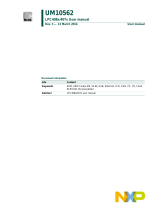
UM10586 All information provided in this document is subject to legal disclaimers. © NXP B.V. 2013. All rights reserved.
User manual Rev. 1 — 14 November 2013 4 of 350
NXP Semiconductors
UM10586
Chapter 1: Introductory information
– Up to 22 General Purpose I/O (GPIO) pins with configurable pull-up/pull-down
resistors, repeater mode, and open-drain mode.
– Up to 9 pins are configurable with a digital input glitch filter for removing glitches
with widths of 10 ns, two pins are configurable for 20 ns glitch filter and another
two pins are configurable for 50 ns glitch filters.
– GPIO pins can be used as edge and level sensitive interrupt sources.
– High-current source output driver (20 mA) on one pin (P0_21).
– High-current sink driver (20 mA) on true open-drain pins (P0_2 and P0_3).
– Two general-purpose counter/timers with a total of up to four capture inputs and
five match outputs.
– Programmable Windowed WatchDog Timer (WWDT) with a dedicated, internal
low-power WatchDog Oscillator (WDOsc).
• Analog peripherals:
– Metrology engine for smart metering with one voltage input, one bias input, from
two up to six current inputs and a temperature sensor.
– Internal voltage reference.
– 10-bit DAC with flexible conversion triggering.
• Serial interfaces:
– USART with fractional baud rate generation, internal FIFO, support for
RS-485/9-bit mode and synchronous mode.
– One SSP controller with FIFO and multi-protocol capabilities.
– I
2
C-bus interface supporting the full I
2
C-bus specification and Fast-mode Plus with
a data rate of 1 Mbit/s with multiple address recognition and monitor mode.
• Clock generation:
– Crystal Oscillator (SysOsc) with an operating range of 1 MHz to 25 MHz.
– 12 MHz internal RC Oscillator (IRC) trimmed to 1% accuracy that can optionally be
used as a system clock.
– Internal low-power, Low-Frequency Oscillator (LFOsc) with programmable
frequency output.
– Clock input for external system clock (25 MHz typical).
– PLL allows CPU operation up to the maximum CPU rate with the IRC, the external
clock, or the SysOsc as clock sources.
– Clock output function with divider that can reflect the SysOsc, the IRC, the main
clock, or the LFOsc.
• Power control:
– Supports ARM Cortex-M0 Sleep mode as reduced power mode.
– Power profiles residing in boot ROM allowed to optimize performance and
minimize power consumption for any given application through one simple function
call.
– Processor wake-up from reduced power mode using any interrupt.
– Power-On Reset (POR).























